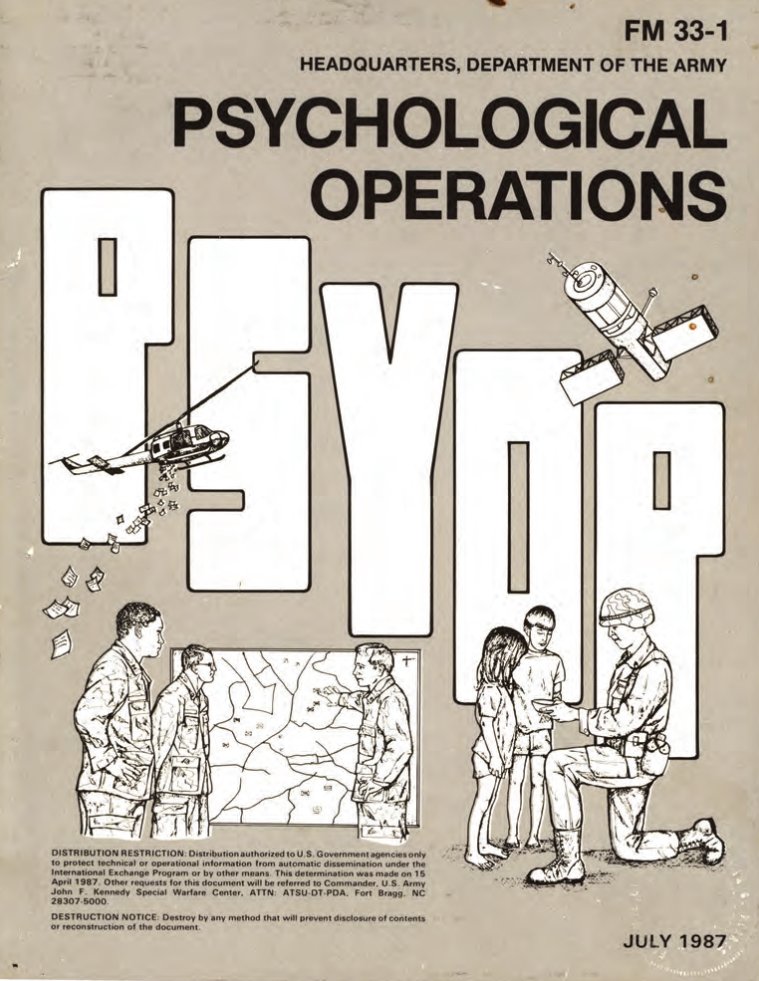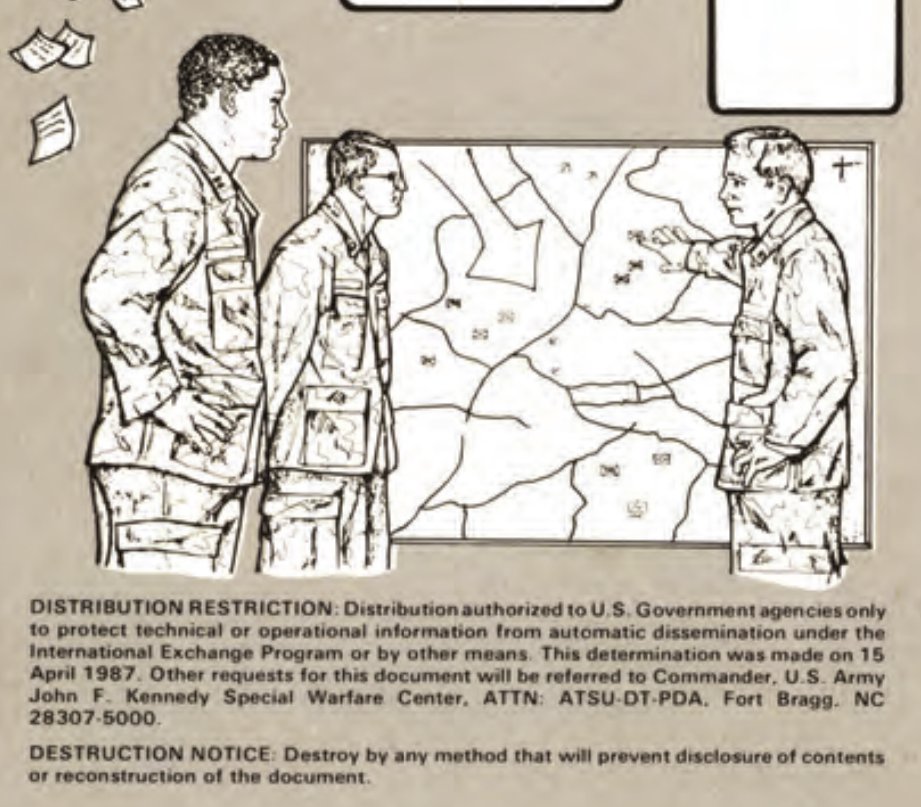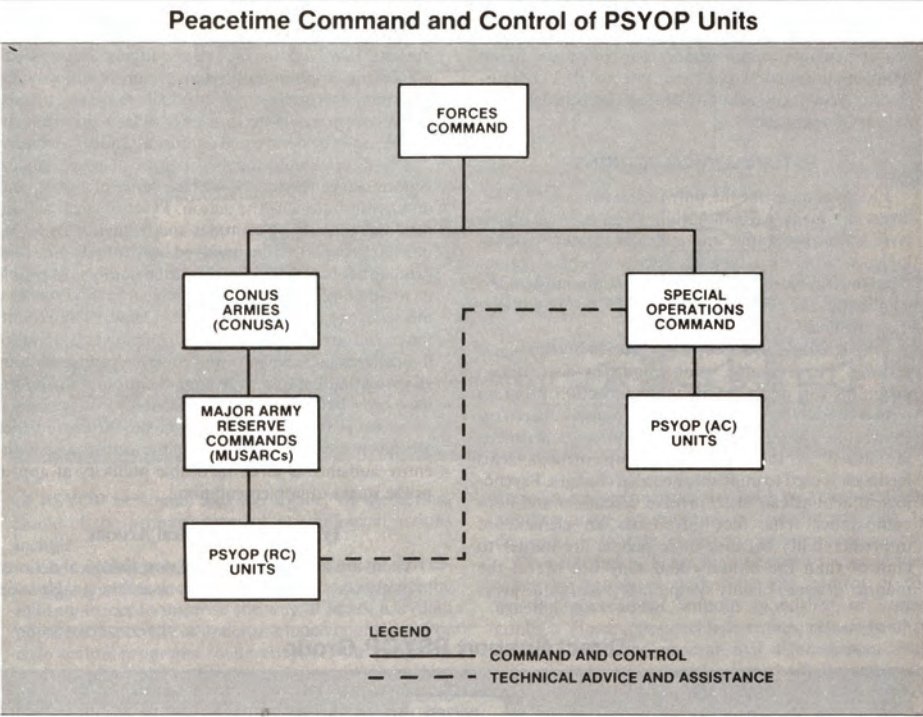Ever heard of the FM 33-1 ?
The Army's Psychological Operations manual from 1987.
🧵 Let's break it down page by page.
The Army's Psychological Operations manual from 1987.
🧵 Let's break it down page by page.

This was a classified document, meant for US Government agencies only. They were meant to be destroyed after reading, as the notice on the bottom of the cover reads:
“DESTRUCTION NOTICE: Destroy by any method that will prevent disclosure of contents or reconstruction of the document.”
“DESTRUCTION NOTICE: Destroy by any method that will prevent disclosure of contents or reconstruction of the document.”

This Peacetime Command and Control of PSYOP Units diagram shows chain of command. Who reports to who and how “technical advice” flows between active duty and reserve units. It’s a literal psyop org chart. 

Here’s how the Army’s “Direct Support PSYOP Group” works. A unified command linking field units directly to psychological warfare teams, with different levels of control depending on the mission. 

The “General Support PSYOP Group” handles broader missions from prisoner-of-war operations (EPW SPT) to civilian influence (CONSOL) and general support (GS). All of these are coordinated under a unified command for large-scale psychological warfare. 

Chapter 4 explains in peacetime, PSYOP policy flows from the President down through the Pentagon to field units. Once a mission is underway, PSYOP commanders integrate influence campaigns into military plans which begin shaping perceptions, morale and behavior just as deliberately as troop movements.

This is the Peacetime PSYOP Policy Flow in detail.
PRESIDENT
The Commander-in-Chief. In peacetime, all military policy including Psychological Operations (PSYOP) ultimately originates here. The President sets the overall national security strategy and approves high-level influence campaign goals.
NATIONAL SECURITY COUNCIL (NSC)
A small group of top advisors and cabinet members (including the President, Vice President, Secretary of State, Secretary of Defense, and others) that formulates and coordinates national security and foreign policy, including the use of PSYOP as a diplomatic and military tool.
NATIONAL COMMAND AUTHORITY (NCA)
This term refers to the President and the Secretary of Defense acting together. The NCA is the only body that can give lawful orders to the U.S. military, including authorizing PSYOP activities. In the chart, it’s shown as a distinct link because it’s the formal authority that passes directives to the military chain of command.
DOD (Department of Defense)
The civilian-led department (headed by the Secretary of Defense) that implements the NCA’s policies. It oversees all branches of the U.S. military and is responsible for making sure PSYOP policies are integrated into defense planning and execution.
DA (Department of the Army)
Within the DoD, the Department of the Army is responsible for policy, planning, and resource allocation specific to the Army. It takes the broad directives from the DoD and turns them into Army-specific PSYOP plans.
FORSCOM (United States Army Forces Command)
The Army’s largest command, responsible for training and preparing active duty and reserve forces for combat and operational missions, including PSYOP missions. FORSCOM channels tasking from the Department of the Army to the operational commands.
CONUS ARMIES (CONUSA)
"CONUS" = Continental United States. These are the regional Army commands within the continental U.S. that manage forces in their area (including PSYOP units) in peacetime.
MAJOR ARMY RESERVE COMMANDS (MUSARCs)
The big regional headquarters that manage U.S. Army Reserve forces, including Reserve Component (RC) PSYOP units. They control administration, training, and readiness.
PSYOP (RC) UNITS
Reserve Component PSYOP units (citizen-soldiers) trained for psychological operations who can be mobilized for active duty when needed.
SOCOM (United States Special Operations Command)
The unified command for all U.S. special operations forces across all services (Army, Navy, Air Force, Marines). Army Special Operations includes active-duty PSYOP units. SOCOM ensures PSYOP integration into broader special operations missions.
PSYOP (AC) UNITS
Active Component PSYOP units are full-time, active-duty soldiers whose primary mission is planning and executing psychological operations often in coordination with special operations.
PRESIDENT
The Commander-in-Chief. In peacetime, all military policy including Psychological Operations (PSYOP) ultimately originates here. The President sets the overall national security strategy and approves high-level influence campaign goals.
NATIONAL SECURITY COUNCIL (NSC)
A small group of top advisors and cabinet members (including the President, Vice President, Secretary of State, Secretary of Defense, and others) that formulates and coordinates national security and foreign policy, including the use of PSYOP as a diplomatic and military tool.
NATIONAL COMMAND AUTHORITY (NCA)
This term refers to the President and the Secretary of Defense acting together. The NCA is the only body that can give lawful orders to the U.S. military, including authorizing PSYOP activities. In the chart, it’s shown as a distinct link because it’s the formal authority that passes directives to the military chain of command.
DOD (Department of Defense)
The civilian-led department (headed by the Secretary of Defense) that implements the NCA’s policies. It oversees all branches of the U.S. military and is responsible for making sure PSYOP policies are integrated into defense planning and execution.
DA (Department of the Army)
Within the DoD, the Department of the Army is responsible for policy, planning, and resource allocation specific to the Army. It takes the broad directives from the DoD and turns them into Army-specific PSYOP plans.
FORSCOM (United States Army Forces Command)
The Army’s largest command, responsible for training and preparing active duty and reserve forces for combat and operational missions, including PSYOP missions. FORSCOM channels tasking from the Department of the Army to the operational commands.
CONUS ARMIES (CONUSA)
"CONUS" = Continental United States. These are the regional Army commands within the continental U.S. that manage forces in their area (including PSYOP units) in peacetime.
MAJOR ARMY RESERVE COMMANDS (MUSARCs)
The big regional headquarters that manage U.S. Army Reserve forces, including Reserve Component (RC) PSYOP units. They control administration, training, and readiness.
PSYOP (RC) UNITS
Reserve Component PSYOP units (citizen-soldiers) trained for psychological operations who can be mobilized for active duty when needed.
SOCOM (United States Special Operations Command)
The unified command for all U.S. special operations forces across all services (Army, Navy, Air Force, Marines). Army Special Operations includes active-duty PSYOP units. SOCOM ensures PSYOP integration into broader special operations missions.
PSYOP (AC) UNITS
Active Component PSYOP units are full-time, active-duty soldiers whose primary mission is planning and executing psychological operations often in coordination with special operations.

Chapter 5 explains the Army’s “cellular concept” for PSYOP. There are 27 specialized team types such as propaganda, printing, loudspeakers, audiovisual, and intelligence that can be combined into companies, battalions, or groups.
Each cell has a specific role in the propaganda pipeline.
F-series teams gather intelligence, analyze targets, and develop messages.
G-series teams print and produce materials.
H-series teams handle loudspeakers, audiovisual production, and mobile broadcasting.
K-series teams operate fixed film, printing, and television capabilities.
Together, these cells form a modular influence system that can be deployed anywhere.
Each cell has a specific role in the propaganda pipeline.
F-series teams gather intelligence, analyze targets, and develop messages.
G-series teams print and produce materials.
H-series teams handle loudspeakers, audiovisual production, and mobile broadcasting.
K-series teams operate fixed film, printing, and television capabilities.
Together, these cells form a modular influence system that can be deployed anywhere.

A typical Direct Support PSYOP Company is built from specialized teams, and not unlike a modern creative agency or production company.
Command and Control (AA) directs the mission.
Supply and Maintenance (BA) keeps the unit running.
Propaganda (FA) creates the message.
Current Intelligence (FC) gathers and analyzes information.
Light Printing (GA) produces leaflets and newsletters.
Platoon HQ (HA) coordinates audio and visual efforts.
Loudspeaker teams (HB) handle live or recorded broadcasts.
Audiovisual (HC) produces film, video, and other visual propaganda.
Together, they can plan, produce, and deliver psychological operations in the field.
Command and Control (AA) directs the mission.
Supply and Maintenance (BA) keeps the unit running.
Propaganda (FA) creates the message.
Current Intelligence (FC) gathers and analyzes information.
Light Printing (GA) produces leaflets and newsletters.
Platoon HQ (HA) coordinates audio and visual efforts.
Loudspeaker teams (HB) handle live or recorded broadcasts.
Audiovisual (HC) produces film, video, and other visual propaganda.
Together, they can plan, produce, and deliver psychological operations in the field.

A Direct Support PSYOP Battalion expands the company structure with more specialized teams.
Command and Control (AB) directs operations at the battalion level.
The Propaganda team (FA) develops messages.
Command Assessment (AD) evaluates the mission environment.
Supply and Maintenance (BA) handles logistics.
Current Intelligence (FC) gathers and analyzes data.
Research and Analysis (FD) dives deeper into target audiences.
Graphic Production (FE) creates visual materials.
Medium Printing Operations (GB) and Medium Printing Press & Processing (GC) handle large-scale production of leaflets, posters, and other printed propaganda.
Command and Control (AB) directs operations at the battalion level.
The Propaganda team (FA) develops messages.
Command Assessment (AD) evaluates the mission environment.
Supply and Maintenance (BA) handles logistics.
Current Intelligence (FC) gathers and analyzes data.
Research and Analysis (FD) dives deeper into target audiences.
Graphic Production (FE) creates visual materials.
Medium Printing Operations (GB) and Medium Printing Press & Processing (GC) handle large-scale production of leaflets, posters, and other printed propaganda.

This chart maps every PSYOP team to each step of the propaganda development process.
From analyzing the supported unit’s mission to collecting intelligence, selecting themes and media, developing and pretesting messages, and finally disseminating propaganda, different team codes (AA, FA, FC, HB, etc.) show exactly who is responsible at each stage. It’s a blueprint for turning policy into targeted influence.
For example, the FC team (Current Intelligence) is marked for steps like Collect Information, Conduct Target Analysis, and Assess Impact.
This means they are responsible for gathering raw intelligence, analyzing the psychological vulnerabilities of a target audience, and later measuring whether the propaganda actually worked.
From analyzing the supported unit’s mission to collecting intelligence, selecting themes and media, developing and pretesting messages, and finally disseminating propaganda, different team codes (AA, FA, FC, HB, etc.) show exactly who is responsible at each stage. It’s a blueprint for turning policy into targeted influence.
For example, the FC team (Current Intelligence) is marked for steps like Collect Information, Conduct Target Analysis, and Assess Impact.
This means they are responsible for gathering raw intelligence, analyzing the psychological vulnerabilities of a target audience, and later measuring whether the propaganda actually worked.

Chapter 8 explains how PSYOP is used in low intensity conflict and special operations. These missions focus on influencing politics, society, and morale without large-scale battles. 

This chart shows the “Spectrum of Conflict”, comparing how likely different types of conflict are and how risky they are.
Low intensity conflicts like insurgencies and terrorism are the most common but less risky to the nation’s survival.
Higher intensity conflicts such as major conventional wars or nuclear war are less likely but carry far greater risks.
Low intensity conflicts like insurgencies and terrorism are the most common but less risky to the nation’s survival.
Higher intensity conflicts such as major conventional wars or nuclear war are less likely but carry far greater risks.

This diagram shows the chain of command for PSYOP when supporting Special Operations.
Orders flow from the National Command Authority to the Joint Chiefs of Staff, then to Unified Commands, then to the Special Operations Command, and finally to Army PSYOP units that carry out the mission.
Orders flow from the National Command Authority to the Joint Chiefs of Staff, then to Unified Commands, then to the Special Operations Command, and finally to Army PSYOP units that carry out the mission.

This chart shows the structure of a PSYOP Group’s Command and Control team.
At the top is the Commander, assisted by an Executive Officer.
Below them are staff sections: HHC (headquarters company), S1 (personnel), S2 (intelligence), S3 (operations), S4 (logistics), and C-E (communications and electronics).
These sections support and direct multiple PSYOP battalions in the field.
At the top is the Commander, assisted by an Executive Officer.
Below them are staff sections: HHC (headquarters company), S1 (personnel), S2 (intelligence), S3 (operations), S4 (logistics), and C-E (communications and electronics).
These sections support and direct multiple PSYOP battalions in the field.

This diagram shows the structure of a General Support PSYOP Battalion.
At the top is Command and Control (AB Team), which oversees the entire unit. Supply and Maintenance (BA) keeps the battalion operational.
The Propaganda team (FA) develops messages.
Printing teams (GB, GC, GD, GE) handle medium and heavy printing for leaflets, posters, and press operations.
Radio teams provide another arm of influence: IA runs mobile radio operations, IB monitors broadcasts, IC provides engineering support, and ID handles mobile radio production.
Supporting teams include Audio and TV Production (FB), Current Intelligence (FC), Research and Analysis (FD), and Graphic Production (FE).
Together, these teams produce, distribute, and measure the effects of propaganda across multiple media.
At the top is Command and Control (AB Team), which oversees the entire unit. Supply and Maintenance (BA) keeps the battalion operational.
The Propaganda team (FA) develops messages.
Printing teams (GB, GC, GD, GE) handle medium and heavy printing for leaflets, posters, and press operations.
Radio teams provide another arm of influence: IA runs mobile radio operations, IB monitors broadcasts, IC provides engineering support, and ID handles mobile radio production.
Supporting teams include Audio and TV Production (FB), Current Intelligence (FC), Research and Analysis (FD), and Graphic Production (FE).
Together, these teams produce, distribute, and measure the effects of propaganda across multiple media.

This chart shows the setup of a PSYOP Consolidation Battalion, which focuses on long-term influence in stabilized areas.
At the top is Command and Control (AB Team).
Supply and Maintenance (BA) supports logistics.
Current Intelligence (FC) gathers information to guide messaging.
Audiovisual (HC), Fixed Motion Picture (KA), Fixed Printing (KB), Fixed Radio (KC), Fixed TV (KE), and Display (KD) teams create and distribute propaganda through film, radio, television, posters, and exhibits.
These units are built to establish sustained psychological operations once control of an area has been secured.
At the top is Command and Control (AB Team).
Supply and Maintenance (BA) supports logistics.
Current Intelligence (FC) gathers information to guide messaging.
Audiovisual (HC), Fixed Motion Picture (KA), Fixed Printing (KB), Fixed Radio (KC), Fixed TV (KE), and Display (KD) teams create and distribute propaganda through film, radio, television, posters, and exhibits.
These units are built to establish sustained psychological operations once control of an area has been secured.

This diagram shows a PSYOP EPW (Enemy Prisoner of War) Battalion.
At the top is Command and Control (AB Team) with supporting sections: Supply and Maintenance (BA), Propaganda (FA), and Current Intelligence (FC).
Specialized teams handle message creation and delivery: Research and Analysis (FD), Graphic Production (FE), Audio and TV Production (FB), Printing Operations (GB and GC), and Audiovisual (HC).
The Platoon HQ (HA) coordinates audio and visual efforts in the field.
Together, these teams are designed to influence and manage prisoner populations through controlled messaging and media.
At the top is Command and Control (AB Team) with supporting sections: Supply and Maintenance (BA), Propaganda (FA), and Current Intelligence (FC).
Specialized teams handle message creation and delivery: Research and Analysis (FD), Graphic Production (FE), Audio and TV Production (FB), Printing Operations (GB and GC), and Audiovisual (HC).
The Platoon HQ (HA) coordinates audio and visual efforts in the field.
Together, these teams are designed to influence and manage prisoner populations through controlled messaging and media.

Did you like this breakdown?
If you want to see more deep dives into declassified documents, follow @ParanoidAmerica
Like and reshare to spread this!
If you want to see more deep dives into declassified documents, follow @ParanoidAmerica
Like and reshare to spread this!
• • •
Missing some Tweet in this thread? You can try to
force a refresh

















